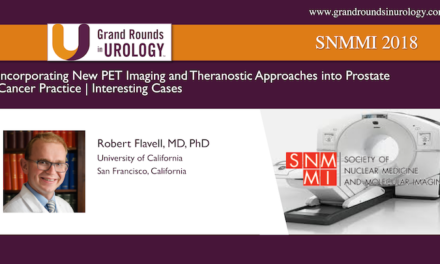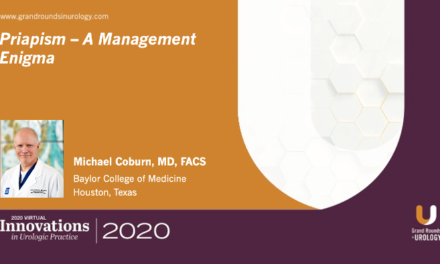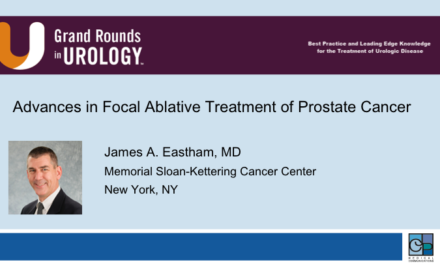Dr. Raoul S. Concepcion spoke at the 25th International Prostate Cancer Update on Saturday, January 24, 2015 on “The History of group Practice Urology: LUGPA’s Past and Future.”
Presentation
“
Keywords: Large Urology Group Practice Association (LUGPA), history, urological care, payment reform, prostate cancer
How to cite: Concepcion, Raoul S. “The History of Group Practice Urology: LUGPA’s Past and Future ” Grand Rounds in Urology. May 1, 2015. Accessed Dec 2024 https://dev.grandroundsinurology.com/prostate-cancer-raoul-s-concepcion-group-practice-urology/.
Transcript
Prostate Cancer Treatment: From Monotherapy to Sequencing
Dr. Crawford, he was gracious enough to invite me back and he really sort of wanted me to give a little update on what’s happening in large group practice. I think this is, so you say, how does this relate potentially to prostate cancer management. And it really does moving forward. I think what I’m going to talk about is really the history of an entity that some of you may know, some of you may not know anything about, which is an organization called LUGPA. It’s Fred Barnes, he was the executive editor of the Weekly Standard, one set in one of our national meetings. It is absolutely the worse acronym in the world in terms of an organization. But at least it’s distinctive and so really what I want to do is walk through with you what LUGPA is, what it isn’t, where we started, and more importantly, I think where we can go in terms of collaborating with the other entities in the field of urology.
Let me give you the history of LUGPA and really what happened was that around the late 90s and early 2000s, TAP Pharmaceuticals which many of you know was basically started… made Lupron and tapasay joint venture between Takeda and Abbott. What they were noticing was that they were getting these large orders of depot Lupron. And really what happened is that they sort of were looking at this and they noticed the consolidation which was happening in every industry. It was happening in the banking business, it was happening in the investor world, and organically what was happening in the United States across large urban areas, was a consolidation of practices.
What was happening is that for example, I’m in Nashville, and so in 1999 we consolidated three practices, not because we were smarter than anybody else, and we thought that we could take advantage of these creation of ancillary services, really why we merged three practices was to leverage our size in order to get contacting for the insurance companies.
It wasn’t about creating radiation services. It wasn’t about creating labs, it wasn’t about necessarily opening up our surgery centers. Truly it was about getting leverage in the insurance world. This was happening again organically across United States. It was happening in Nashville, it was happening in Indianapolis, it was happening in Baltimore, Philadelphia, Cincinnati, Ohio, Denver, Kansas City. Everybody was trying to basically trying to get a better contract.
Now because of that, and because of obviously our management of prostate cancer patients, what TAP was seeing is that they were getting these large orders from groups all across the country. And so the folks in Cincinnati, Ohio, Gary Kirsh, Bill Monnig and they’re administrator Earl Walz, worked with TAP and they started to invite a number of us to come to Chicago. They invited both physicians and administrators, and they said, why don’t you guys come up? What we’re seeing is that large groups of… there is this consolidation of the industry. And it really wasn’t a clinical meeting, it was really to bring like minded physicians and administrators together, sit them in a room and let’s talk about the challenges that large groups face which are very, very different from smaller groups and obviously from our brethren in the academic centers.
What happened is that in 2000, I think there were about 10 or 12 groups and this slowly started to gain traction. This is where the urology network, where many of our friends really started to meet in which started off as 10 groups, then grew to 15, then grew to 20, then grew to 25. This was really happening all by word of mouth. TAP didn’t advertise it. The world as you know of urology is quite small, and then next thing you know, this was up to about 35 to 40 groups. And at that point it really became very much unsustainable for TAP to really fund this because what they would do, again they would fly up a physician, fly up an administrator. We would meet in the first week of November in Chicago and all expenses were paid. Everybody wanted to come to this “TAP meeting.”
I remember in about 2007, 2008 I was walking in a hospital and my friend Gary Kirsh calls me and says, hey Raoul, we’re going to start a formal organization. We’re going to call it the Large Urology Group Practice Association, and we really want you to be on the Board because you’ve been going to this meeting since the early 2000s. That actually was how it started and again we held our first meeting in 2009. We had 40 groups that attended and again it was a physician and administrator, we were true to our initial meetings in that we always held our meeting in Chicago the first week of November. Anybody who wants to know, why is LUGPA held differently at a different time from the AUA? Because that’s where we started.
This was actually the first Board. This was actually the first Board of LUGPA. And again Bill Monnig from Ohio was the President. You remember Bill, Earl and Gary really did a lot of the lifting. They were working, it was sort of their idea, they were working closely with Wendy Wiser [phonetic] from Illinois. This was the first Board. Again, Peter Knapp who is here in the audience, Peter was President Elect and then the rest of the Board was Deepak Kapoor from IMP in New York, myself, Neal Shore who’s also here from Myrtle Beach, John House from Forth Worth, Juan Reyna from San Antonio, Sandy Siegel from Chesapeake Urology, Tom Brown, Tom actually was interesting. Tom held three board positions simultaneously in all three organizations. He was on the Board of the AUA, he was on the Board of AACU and he was actually on the Board of LUGPA. And true to what we had started, we also had administrators, so we had Jason Shelnutt from Atlanta, Georgia, Earl Walz obviously from Ohio, and Bob Asinof from right here in Denver, Colorado.
What is LUGPA? Again, it’s the Large Urology Group Practice Association. It’s really a trade association. It is an organization of organizations. The physicians aren’t the members, it’s the groups are the members. It wasn’t designed to be a clinical organization, it was really designed to really do advocacy up on Capitol Hill for the dedication and preservation of independent practice. We would like to consider ourselves sort of the last bastion of independent practice here in the United States.
And again, the whole goal was again maintain independent practice and again what was happening now through the 2000s which was different from the “early” LUGPA groups was that the groups were taking advantage of what we call the Stark II In Office Ancillary Service Exception. And basically for those of you who aren’t familiar with the exception, it allows large integrated groups to basically own and deliver services. It allows us to have pathology, surgery centers, lab, imaging, and in certain states depending if you have a certificate of need state, you can even have your own radiation centers. In some places you can actually joint venture and have your own hospital. So that’s what it was about. It was about advocacy, and it was about the preservation of the current business model in which most of us practice.
Again, it’s not a clinical organization, it’s not a buying group, it’s not a GPO, and it wasn’t as many people view LUGPA, it’s not all just about radiation. It is about the preservation of the exception and advocacy. Letting people know up on Capitol Hill what not only large groups do, what we as urologists do, because prior to that we really hadn’t done a very good job and again this is very important.
So we basically like to say we had this 4 legged stool. We had great legal people with us in DC. And our attorney that we use is a guy named Howard Rubin. We also have a federal affairs group with John McManus. We have a PR firm of Powell and Tate. But really what’s important is really the membership of the organization.
The vision of LUGPA, how we described it in 2008 was to be the premier organization of group practices committed to the delivery of high quality and efficient comprehensive urological care. And again, we would sit in Board meetings and Peter Knapp was there, Neal was there, and a lot of this we as I say, we were kind of making this up as we go.
We knew the importance of large groups, we knew the importance of what we need to be doing, and we really felt this was an opportunity because again we didn’t feel at the time, and I’m not throwing them under the bus, we just really didn’t really feel that the AUA and the AACU really were representing what we as large groups needed to be doing.
This was our mission statement. I’m not going to read this to you because it is without a doubt the worse run on sentence that there is.
What were the requirements? And again we just sort of said, we had to be independent. So what does independent mean? And it was defined as a separate tax ID billing number. And what was large? We arbitrarily said, you had to have 10 or more urologists in your group, but we wanted to be more inclusive as opposed to exclusive, and so we said, okay, we’re going to say 10 but we’re going to create an associate category that if you have five recognizing the fact that you don’t have… there were going to be some groups that don’t have to have 10 in order to control their market share. We actually made an associate category, a five, actually five is now the official number in order to be a full member of LUGPA, and that’s five urologists. The other thing is that we don’t necessarily eliminate academic groups or large clinics. In fact we do have one academic group that applied for membership and we just basically said, if there was a large clinic, if there was an academic group that met this criterion, we would take that on an individual basis.
We worked very diligently and we had growth pretty much every year. I was fortunate enough to take over after Dr. Knapp, then Dr. Kapoor, then we decided because of what we were doing on the Hill, large necessarily didn’t play well. Large doesn’t necessarily play well. So we talked about in a meeting, we talked about rebranding. We talked about all the different acronyms that we could use but we were so successful over the first few years we had such a recognizable name that we basically made a decision to say okay, we’re going to keep LUGPA, but we’re going to try to really rebrand ourselves. And so as I’m currently standing here, LUGPA has about 120 groups. We are in 37 states. Pure guesstimate is that we’ve got about within those 120 groups, that encompasses about, that’s over 2,500 urologists. Depending upon what number you want to use, that’s about 20% to 25% of the practicing urologists here in the United States. That’s where we stand today.
And again, we’ve gone away from trying to stress large, big, and basically our mission statement now is to preserve and advance the independent practice of urology. And our tagline is really our quality, collaboration, innovation, and integrity. That’s where LUGPA is today.
Here’s the current Board, Gary Kirsh from Ohio is the current President. We’ve actually gone from a one year term to a two year term. My good friend Neal was the secretary last year. He is now President Elect. Juan Reyna was our Past President, and again this is our current Board that exists. And again what we do is that we have both physicians and administrators as part of the Board.
Moving forward, what can we do? And what we realized is that yes, we were never a clinical entity but we also realized that as medicine is moving forward, especially with alternative payment reform models, that we have a unique ability to gather large amounts of data within our practices especially on the clinical side. And so what we’ve tried to do is move the ball forward and really still however maintain this concept of being working on the Hill for advocacy. In terms of working with the other entities, specifically the AUA and AACU, we are what we now have an official stance in the Joint Advocacy Conference in Washington D.C. We have two voting members as part of UroPAC. Neal Shore is an official Board is on the Board of SUO. We have routine AUA calls with the current presidents held in a number of health policy efforts with Dave Penson who again is now the chair at Vanderbilt. We also take–there is the AACU also has a State Society meeting and usually what we do is that the sitting president of each of the organizations shows up at the AACU and talks about what each of the organizations are doing.
On the clinical side, again we are understanding that data is going to become the new currency. We’re not going to be able to do anything without data. So what we’ve done is that actually we were fortunate to get a $350,000 grant from Genomic Health, for clinical benchmarking and the use of active surveillance in prostate cancer. We’ve actually conducted our own internal studies, in response to some negative articles that were published about the field of urology. We did a large scale study on the use of IMRT across LUGPA groups versus freestanding centers, hospital based centers. We actually did a large scale study on prostate biopsies in large groups. Over 400,000 patients, over 4.2 million cores, 4.2 million cores. What we found is that across big groups there was a 40% positive predictive value using traditional ultrasound and biopsy technique. Not what was being touted by Gene Mitchell using about 10,000 cores of 25%.
Neal has been very successful in doing CME courses for the past three years. We also now, we entered into a contract with Med Reviews as the official LUGPA journal. So again, LUGPA, it’s changed. It’s not all just about radiation but we really do believe that it is still, it is the last bastion of independent practice because as many of you know, if we lose independent practice then we will all get moved into hospitals, integrated systems, which I think really is going to be bad not only for physicians, but as well as urology.
Future efforts: Practice benchmarking; we’re looking at alternative payment models; continue support of the In Office Exception; and again it’s not really a LUGPA project, but Neal and I and Dan Saltzstein in San Antonio have created a research consortium using the strength, using the capabilities of large groups.
ABOUT THE AUTHOR
Raoul S. Concepcion, MD, FACS, is the Chief Science Officer of U.S. Urology Partners in Nolensville, Tennessee. He was a resident in General Surgery and Urology at Vanderbilt University from 1984-1990, and later served as a Clinical Associate Professor of Urology there.
Dr. Concepcion’s clinical interests revolve around advanced prostate and bladder cancer management. He is a past President of LUGPA. Along with two other urologists, he founded CUSP, a urologic research consortium in the United States. Additionally, he is an advisor and/or speaker for many companies, including Dendreon, Pfizer, Astellas, Amgen, Cellay, and Janssen, and has served as editor for Urologists in Cancer Care.





